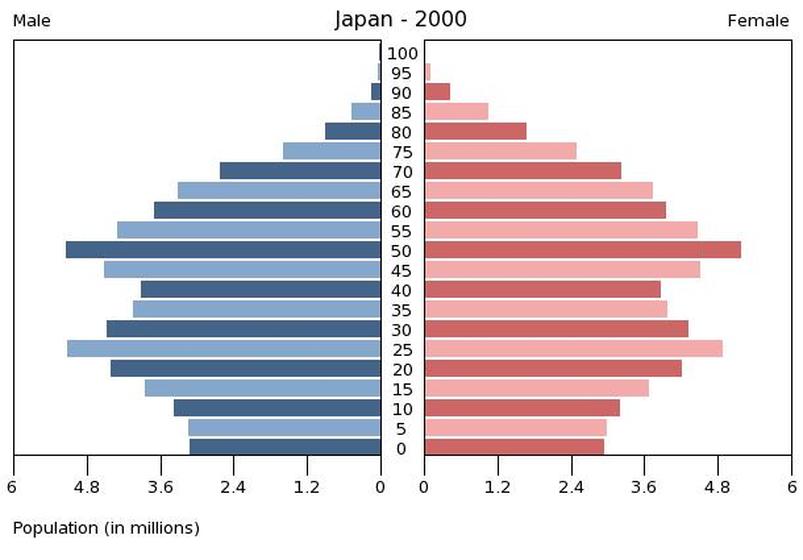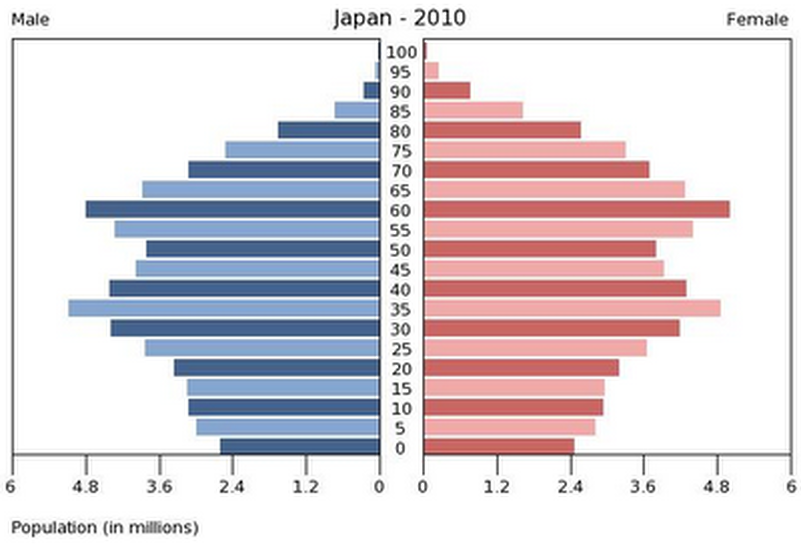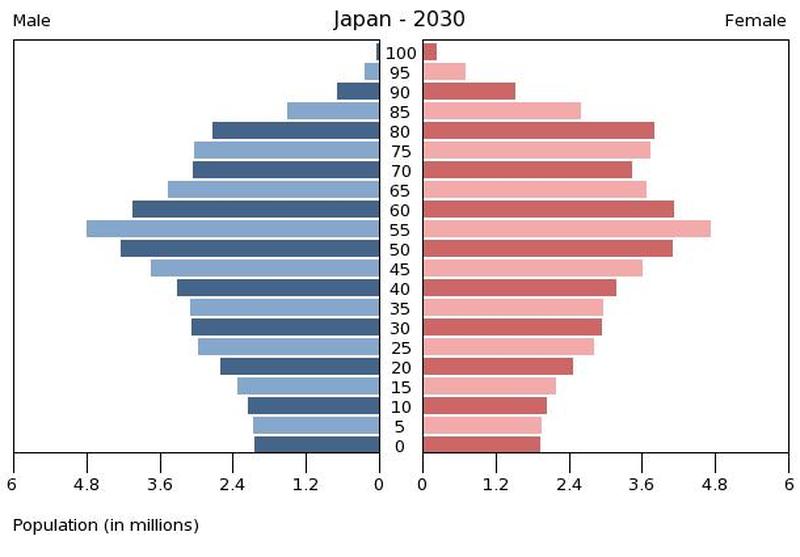Major Demographic Characteristics

Some major demographic statistics about Japan:
Japan has the highest life expectancy in the world, with almost 86 years for females, and almost 79 years for males (CIA World Factbook) . There is a very low infant mortality rate, 2.8 in a thousand, and a relatively low birth rate as well, at 7.41 births in a thousand (CIA World Factbook). However, the death rate, 9.83 deaths in a thousand, is higher than the birth rate, which means 2 more people are dying in a thousand than being born (CIA World Factbook). Its population is the 10th in the world, because of its baby boom before the WWII and in the 20th century, but it will soon decline (CIA World Factbook). As well, its population is a highly educated one, with only 1% being illiterate (CIA World Factbook). Japan is very crowded, with 12.8 million people in just Tokyo (US Department of State), because it is a small, and generally inhabitable country with many mountains and volcanoes (CIA World Factbook, US Department of State). As there are not a lot of living spaces, but a lot of people, it is very dense.
Japan has had extreme growth starting from 1868. However, it dropped drastically after the second world war, with better health care, a long life span and low birth rates becoming desirable (Encyclopaedia Britannica). Birth rates rose again in the 20th century, and started declining for the first time in 2005, although the first predicted decline was in 2007 (US Department of State). Now it is practically stagnant in the 21st century (Encyclopaedia Britannica), with death rates rising - because of good health care and focus on seniors, the senior population of Japan has risen, while the young population has not changed, which means birth rates are low and death rates are rising, stage 5 of demographic transition (CIA World Factbook).
- Population = 126 804 433 (CIA World Factbook)
- 10th in the world (CIA World Factbook)
- population growth rate = -0.242% (CIA World Factbook)
- Birth rate: 7.41 births/1000 (CIA World Factbook)
- Death rate: 9.83 deaths/1000 (CIA World Factbook)
- 99% of the population is literate (CIA World Factbook)
- Life expectancy: highest
- Female: 85.66 (CIA World Factbook)
- Male: 78.87 (CIA World Factbook)
- 5th stage of demographic transition: low birth rate, higher death rate (CIA World Factbook)
- Infant mortality rate = 2.8 per 1000 (CIA World Factbook)
Japan has the highest life expectancy in the world, with almost 86 years for females, and almost 79 years for males (CIA World Factbook) . There is a very low infant mortality rate, 2.8 in a thousand, and a relatively low birth rate as well, at 7.41 births in a thousand (CIA World Factbook). However, the death rate, 9.83 deaths in a thousand, is higher than the birth rate, which means 2 more people are dying in a thousand than being born (CIA World Factbook). Its population is the 10th in the world, because of its baby boom before the WWII and in the 20th century, but it will soon decline (CIA World Factbook). As well, its population is a highly educated one, with only 1% being illiterate (CIA World Factbook). Japan is very crowded, with 12.8 million people in just Tokyo (US Department of State), because it is a small, and generally inhabitable country with many mountains and volcanoes (CIA World Factbook, US Department of State). As there are not a lot of living spaces, but a lot of people, it is very dense.
Japan has had extreme growth starting from 1868. However, it dropped drastically after the second world war, with better health care, a long life span and low birth rates becoming desirable (Encyclopaedia Britannica). Birth rates rose again in the 20th century, and started declining for the first time in 2005, although the first predicted decline was in 2007 (US Department of State). Now it is practically stagnant in the 21st century (Encyclopaedia Britannica), with death rates rising - because of good health care and focus on seniors, the senior population of Japan has risen, while the young population has not changed, which means birth rates are low and death rates are rising, stage 5 of demographic transition (CIA World Factbook).



